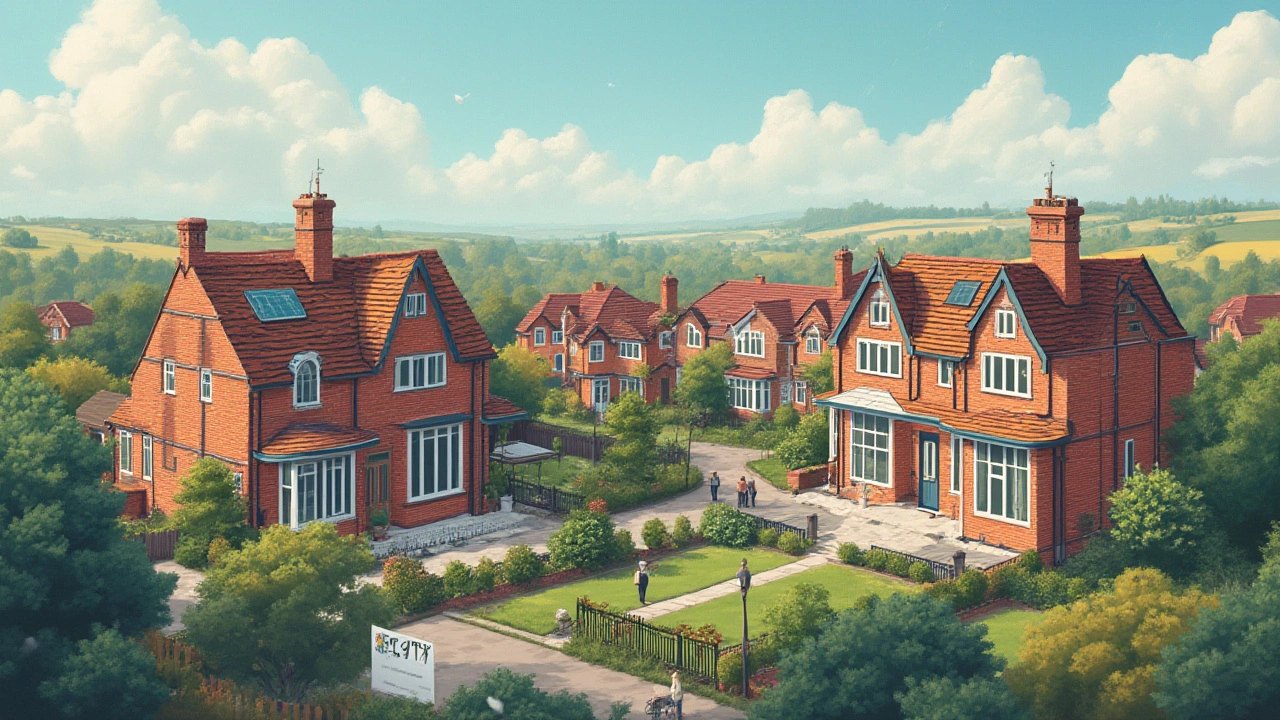Picture this: You just finished binge-watching a renovation show, dreaming of your own upgraded kitchen. Suddenly, your friend mentions they pay double your rate for homeowners insurance—same city, same house size. Why? Who’s walking around with the most expensive homeowners insurance, and what does that even cover? Home insurance prices don’t just drop from the clouds—they’re calculated behind the scenes, based on risk, location, claims history, and the quirks of specific companies. The difference can mean hundreds, sometimes thousands, added to your annual bill. So, let’s unravel where the sky-high rates come from, which companies have the priciest premiums, and why some folks are stuck paying more than others for what’s basically the same protection.
What Makes Homeowners Insurance So Expensive?
If it feels like your insurance bill’s growing faster than your grass after a rainy spring, you’re not imagining it. A lot goes into those numbers on your statement, and sometimes they don’t make sense at first glance. The culprits? Your zip code’s claim history, how close you live to the coast, wildfire risk, your home’s age, its building materials, and recent renovations—they all mix into the premium stew.
Let’s break down a few examples. Live in Florida or Louisiana? Hurricanes will jack your rates. Some Texas and California areas are hammered by hail or wildfire, making coverage pricey. Now add in rebuilding costs—lumber, labor, roofing are all shooting up. Insurance companies price for risk, and if your neighborhood’s seen lots of claims, you end up subsidizing those losses even if your own record is squeaky clean.
But it’s not just about geography. Your individual history counts. Have you filed a water leak claim? That sticks with you—and if you had a pipe burst three years ago, don’t be surprised to pay more. Got a pool, trampoline, or aggressive dog? Up goes your premium for extra liability. Even your credit score gets factored in (except in California, Maryland, and Massachusetts, where using credit for pricing is banned). People with low credit, in high-risk zip codes or older homes, can see quotes from some companies nearly twice as high as the neighbor up the street.
Insurance companies change rates all the time, too. Major carriers in 2025—think State Farm, Allstate, and Farmers—have been publicly filing rate hikes ranging between 8% and 16%, with some states approving increases north of 30%. Massive storms, such as the New Orleans flooding in late 2024, cost tens of billions—costs that insurers spread into next year’s rates. It’s a cycle: climate disasters hit, insurance companies pay out, then everyone’s premiums edge up.
Here’s a fact that’ll raise your eyebrows: in Florida, the average annual homeowners insurance bill was about $6,000 in 2024, triple the national average. That’s no typo. In California, wildfire-prone areas now see annual bills upwards of $5,000, with some policies even dropped entirely by major insurers out of fear of future losses.
If you’re wondering how rates went from reasonable to shocking, blame inflation too. Increased costs for construction material and labor after the pandemic are major drivers. According to the Insurance Information Institute, the cost to rebuild an average U.S. home jumped nearly 20% since 2021. Insurers need to prepare to rebuild from scratch, not at yesterday’s prices but at today’s. That difference gets passed on line by line.
All these moves mean the same 1,800-square-foot home in Ohio could be insured for $1,200 a year, but run $8,500 on the Florida coast—sometimes with less coverage. Nothing else in your budget swings this much just by moving zip codes.
The Most Expensive Homeowners Insurance Companies in 2025
Not all insurance carriers quote the same price for the same house. Some are more conservative about risk, some are struggling with their loss history, and others specialize in high-risk areas, charging premiums to match. As of July 2025, several companies consistently stand out for sky-high pricing, especially in states plagued by weather disasters.
Nationally, Farmers Insurance has the dubious honor of being one of the costliest options, especially for those living in tornado or wildfire-prone regions. Reports from the NAIC (National Association of Insurance Commissioners) confirm that their average annual premium in Texas shot above $5,800, with California and Colorado coming just behind. State Farm is right at their heels, especially in coastal areas, where many homeowners are reporting $7,000 bills—not for mansions, but for average three-bedroom homes. Florida-specific carriers, like Citizens Property Insurance Corporation, have even higher numbers, but those are unique to that hard-hit market due to a lack of other private options.
| Company | Average Annual Premium (High-Risk State) | Coverage Limits Noted |
|---|---|---|
| Farmers Insurance | $5,800 | $300,000 Dwelling/ $300,000 Liability |
| State Farm | $7,000 (FL, LA, TX) | $300,000 Dwelling/ $500,000 Liability |
| Allstate | $5,400 (TX, CA) | $300,000 Dwelling/ $300,000 Liability |
| Citizens (FL) | $7,900 (avg. FL) | Varies (often less than private market) |
| AIG | $10,000+ (Custom Luxury) | $1M+ Dwelling/Liability |
In some states, smaller companies or specialty insurers jump in with even higher premiums, especially if you need windstorm, flood, or earthquake add-ons that aren’t part of a base policy. Places like the Gulf Coast or wildfire areas around Los Angeles often require policy stacking: a high base price for standard homeowners insurance, then more for separate wind or wildfire coverage, as traditional insurers pull back from those zones.
For luxury homes or those with unique risks (historic houses, high-end renovations), premiums balloon fast. AIG, Chubb, and PURE Insurance—brands that focus on high-value properties—host policies starting at $10,000 annually but often reach $30,000 or more, especially if the home’s a flagship on the block. For regular folks, though, it’s carriers like Farmers, State Farm, and Allstate leading the “most expensive” sweepstakes in typical American neighborhoods considered high risk.
Here’s the kicker: premiums vary by company, but even the same company will quote wildly different prices based on address, roof material, local crime rates, and history of disasters or big insurance losses within a few miles. It really does pay to shop those rates. If you haven’t, you might be missing out on hundreds—possibly thousands—in annual savings.

Factors That Cause Price Differences Between Insurers
Okay, so we’ve seen that location, company, and coverage limits make a massive difference. But what really drives one insurer’s price up while another stays reasonable? The answer digs deep into risk tolerance, corporate profits, local reinsurance deals, and state laws.
First, each company sets their own appetite for who they want to insure. Some carriers refuse to write new policies in certain areas—like those hit repeatedly by hurricanes, wildfires, or even lawsuits (looking at you, southern Florida). Others specialize in niche markets, like historic homes or properties in high-claim, high-fraud urban neighborhoods. When insurers get scared, they either exit the market or jack up rates to stay profitable. Insurers call this “underwriting discipline”—you feel it as a fat bill.
Legislation matters too. In states like California, regulations prevent frequent rate hikes. But that’s led some national companies to pull back, creating a shortage of options (and higher rates from those who remain). This tight supply means less competition and no incentive to lower prices.
Reinsurance is a hidden player. Insurance companies themselves buy insurance—from reinsurers. If you’ve had a year of massive payouts (like Texas after a supercell hailstorm), the cost for companies to insure themselves goes up, so your premium follows. Reinsurance costs spiked up 18% in 2024, especially for hurricane or wildfire zones. You’ll feel that ripple effect at renewal.
Some companies also bundle risk by policy type. If a carrier’s auto insurance division is losing money in a state but their homeowners branch is profitable, they may still hike home premiums to cushion the auto side. Not fair? Maybe not, but that’s how company finances work.
Technology plays a part, too. Some insurers now use smart home data—think water shutoff sensors, fire alarms, and even home security apps—to verify you’re a low-risk customer. Companies like Hippo and Lemonade trumpet discounts for tech-savvy homeowners, but the flip side is that old houses without upgrades (or with outdated wiring and plumbing) end up slapped with higher rates. Traditional companies are slow to adapt here, which is one reason their legacy portfolios (and their rates) can be higher, especially for older homes.
A lot of customers don’t realize that one water leak or dog bite claim may stay on your record for five years, causing rates to edge up at every renewal. High-claim customers get assigned to pricier “tiers” within an insurance company, often without being told. Two neighbors with identical houses, but different claim histories, could pay hundreds apart.
Credit is huge, too. Although some states block insurers from using credit scores, most tie pricing directly to how you manage money. Folks with low credit pay up to 40% more for the same coverage, based purely on the correlation with increased claims.
On top of all this? Rate filing delays. Sometimes insurers take a loss for months before regulators allow them to raise premiums. When they do, catch-up hikes can be brutal, forcing everyone into higher tiers all at once. The best defense is to shop, check annual reports, and not take your renewal price as inevitable.
Tips To Avoid the Highest Homeowners Insurance Rates
So, if “most expensive” seems to be lurking at your mailbox, what can you actually do? Good news—there are smart ways to cut back. Here’s how real people save, backed by recent industry tips and success stories from 2024 and 2025:
- Shop annually: Don’t let loyalty drain your wallet. Every year, especially after a rate hike, set aside thirty minutes to compare quotes from at least three competitors. Many companies are quietly hungry for new customers, so you might snag a new-customer discount.
- Bundle up: Pairing your homeowners and auto coverage with the same company often lands discounts of 10–30%. It’s not automatic, though—you have to ask and sometimes negotiate.
- Raise your deductible: If you can stomach paying more out of pocket in a claim, lifting your deductible from $1,000 to $2,500 can shave 10–20% off your premium.
- Upgrade your home: Insurers love risk reducers: installing a new roof, wind-resistant windows, storm shutters, or home security systems. Some states (like Florida) even require credits for these improvements by law—just make sure you submit proof after the work.
- Improve your credit score: Even a small boost can drop your premium. Pay down debts, check your credit report for errors, and avoid opening new credit lines right before shopping quotes.
- Stay claims-free: Only file major claims. For small stuff (think under $5,000), it’s often cheaper long-term to fix it yourself and preserve your “clean” discount tier with your insurer.
- Check for location-specific programs: Some regions now run “insurance pools” or joint underwriting associations for people who can’t find private coverage. These are often expensive, so try private carriers first.
- Call your agent: A quick chat can uncover obscure discounts: affiliations (military, alumni), payment-in-full rebates, or even loyalty credits if you’ve been with a carrier for years.
- Review your rebuild value: Don’t over-insure. Check to make sure your “dwelling coverage” matches rebuild costs, not inflated real estate values, which include land and location (insurers only need to rebuild the building itself).
Prices in 2025 are higher, but plugging away at these steps can turn a $5,800 bill into $3,900—or less. It’s worth the time and the awkward phone calls.
No one likes paying more than necessary. Whether you’re fighting off Florida rates or just want to beat a “loyalty penalty” from a legacy carrier, knowing which companies are priciest, why the difference exists, and how to avoid the worst of it helps keep your budget—if not your roof—intact.

